While springtime might be the typical time many foragers go out to hunt down choice edible mushrooms, summertime can also be a fantastic time to search for your favorite fungi. If you live in a climate that is particularly rainy in the summer, then you could have an excellent opportunity to forage for wild mushrooms found in summer!
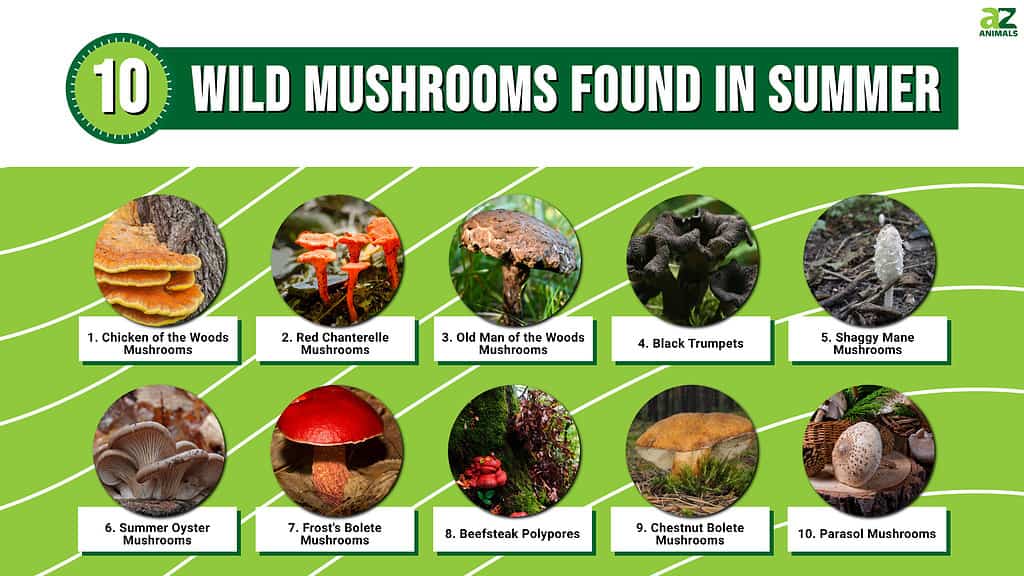
In this guide, we’ll explore ten of the best mushrooms to forage for when the sun is shining. All of the mushrooms on this list are edible but keep in mind that some may need to be cooked first before consuming. Just as well, some of the following mushrooms can have some pretty toxic doppelgangers, so be sure to familiarize yourself with poisonous and edible mushrooms before venturing out to forage mushrooms.
1. Chicken Of The Woods Mushrooms
The chicken of the woods mushroom is classified as laetiporus sulphureus. This mushroom is quite hard to mistake for any other mushroom, is a favorite of mushroom foragers and foodies alike, and even just one cluster of mushrooms is typically plenty for several meals. Around June or July, this fungus is at full fruiting maturity and may be seen growing on the sides of trees.
As a saprotrophic fungus, commonly referred to as a decomposer, chicken of the woods grows on dead and decaying trees, especially oaks. Look for them on logs, stumps, and other standing timber in established oak forests. In addition, hemlocks may be home to chicken of the woods mushrooms. It is best to avoid eating these mushrooms since eating chicken of the woods that has been growing on hemlock might irritate your stomach.

Chicken of the woods (pictured) can grow on the sides of tree trunks.
©Marc Venema/Shutterstock.com
2. Red Chanterelle Mushrooms
The red chanterelle mushroom is classified as cantharellus cinnabarinus. All across North America, Eurasia, Central America, and Africa, red chanterelles can be found in coniferous woods. They often appear in the late summer and develop in bunches among the moss.
Typically funnel-shaped, meaty, and yellow or golden in color, chanterelles are mushrooms. Simply said, crimson chanterelles have deeper orange or red hues that are a little richer in color. The stem of the mushroom has ridges that resemble gills under the cap, and it may smell sweet, woodsy, or earthy overall.
Be cautious of imitator mushrooms that may look like the red chanterelle. The false chanterelle that is inedible is darker, with a core that is darker and margins that are lighter. It’s not harmful, but it tastes horrible. Chanterelles and jack-o-lantern mushrooms might be mistaken for one another as well. The smooth, blunt, and shallow gill-like ridges of a chanterelle are significantly thicker, deeper, and more delicate than the gills of a jack-o-lantern mushroom. The jack-o-lantern mushroom is poisonous.
Red chanterelles frequently taste lightly peppery. They are quite rich and frequently prepared with cream, butter, or wine.

Red chanterelle mushrooms (pictured) can be easily identified by their bright orange hue.
©K Quinn Ferris/Shutterstock.com
3. Old Man Of The Woods Mushrooms
The old man of the woods mushroom is classified as strobilomyces floccopus. Most foraging communities don’t pay much attention to the old man of the woods mushroom, but it’s actually an excellent starter mushroom, especially for those looking to increase their foraging expertise and go into the realm of boletes. Very few mushrooms have the same appearance as the old man of the woods.
The distinguishing characteristics include a velvety, molted cap with a pored surface rather than a gilled surface on the underside. They don’t grow in clusters and have scruffy stems. When cut open, they often bruise pinkish before becoming black.
The old man of the woods mushroom is definitely edible even if it isn’t regarded as a preferred food and adds an earthy taste to any meal it is added to. The flavor of old man of the woods is frequently compared to that of button mushrooms from the supermarket.
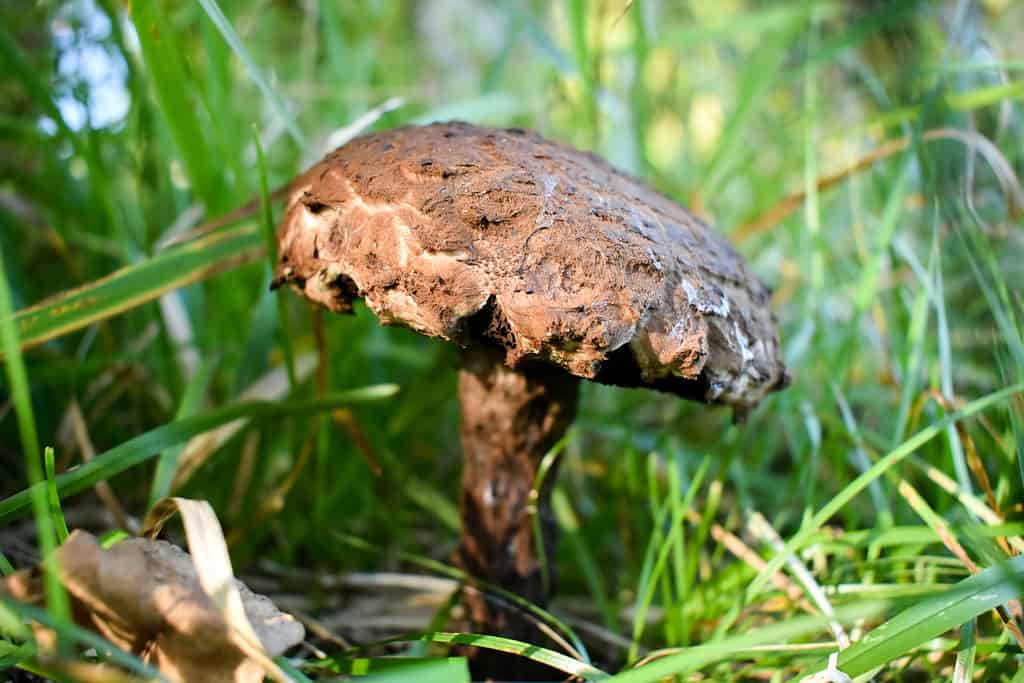
Old man of the woods mushrooms (pictured) are edible, but not particularly popular in cuisine.
©Kuzmalo/Shutterstock.com
4. Black Trumpets
The black trumpet mushroom is classified as craterellus cornucopioides. In mossy hardwood woods, which are prevalent across North America, you can find black trumpet mushrooms. They thrive in wet, gloomy places and frequently grow next to streams and washes. The optimum times to collect these lovely flowers are in the summer and fall.
These mushrooms may be quite difficult to find and thrive in leaf litter. However, they tend to grow in large groups, so if you come upon one, you’re in luck! This mushroom’s cap is fashioned like a vase or a trumpet and is inky black, dark brown, or grey. The underside is smooth and devoid of pores or gills. Small scales may be present at the top of the cap, but otherwise, it has a smooth or hardly wrinkled appearance.
The taste of these mushrooms is deep and smokey. Since they are frequently pretty unclean, wipe them down before cooking. If dried, black trumpets retain their taste nicely as well. They taste great when dried and added to soup or grain dishes, or cooked with oil and garlic.
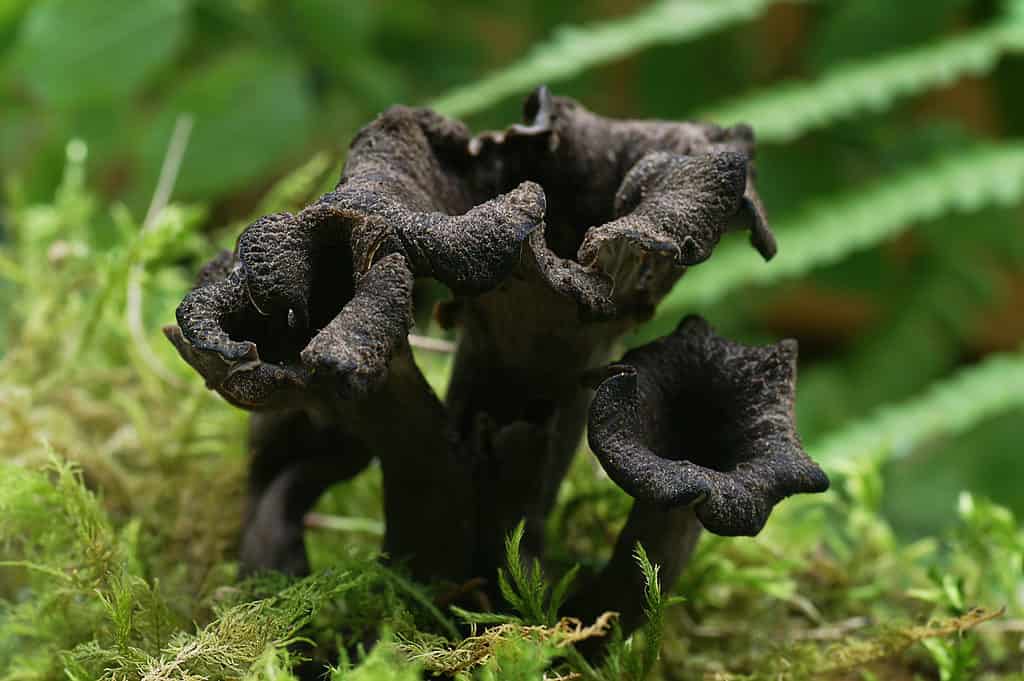
Black trumpet mushrooms (pictured) are very dark and often difficult to spot when foraging.
©Gaby Fitz/Shutterstock.com
5. Shaggy Mane Mushrooms
The shaggy mane mushroom is classified as coprinus comatus. In the summer, shaggy mane mushrooms may be seen fruiting in meadows and grasslands all throughout North America and Europe. If you reside in a hot area, we advise searching for these mushrooms early rather than later, between June and July.
Only the juvenile stage of this species, before the gills become black, is edible. When young, its shaggy head, which is coated in loose scales, hangs over a large portion of the stem. In a flash, the gills change color from white to pink to black. The gills of this species must be picked before they darken. Because it contains a lot of water, this mushroom is a fantastic addition to stocks and soups, particularly risotto.

The shaggy mane mushroom (pictured) has a shaggy appearance to their caps, hence their name.
©Rita Romanyshyn/Shutterstock.com
6. Summer Oyster Mushrooms
The summer oyster mushroom is classified as pleurotus pulmonarius. Here is another type of mushroom that is simple for beginners to gather! On wood, such as decaying logs or tree trunks, oyster mushrooms frequently grow. They come in a variety of hues, from white to light pink to pale brown. The simplest method to recognize oyster mushrooms is to check for their short, crooked stems and pure white gills. They grow in clusters on dead or dying trees, which is another characteristic of their growth style.
The growth season for oyster mushrooms is also longer than that of other kinds. Depending on where you live, you can find them throughout the summer, fall, winter, and spring. Additionally, they may be utilized in a variety of recipes.
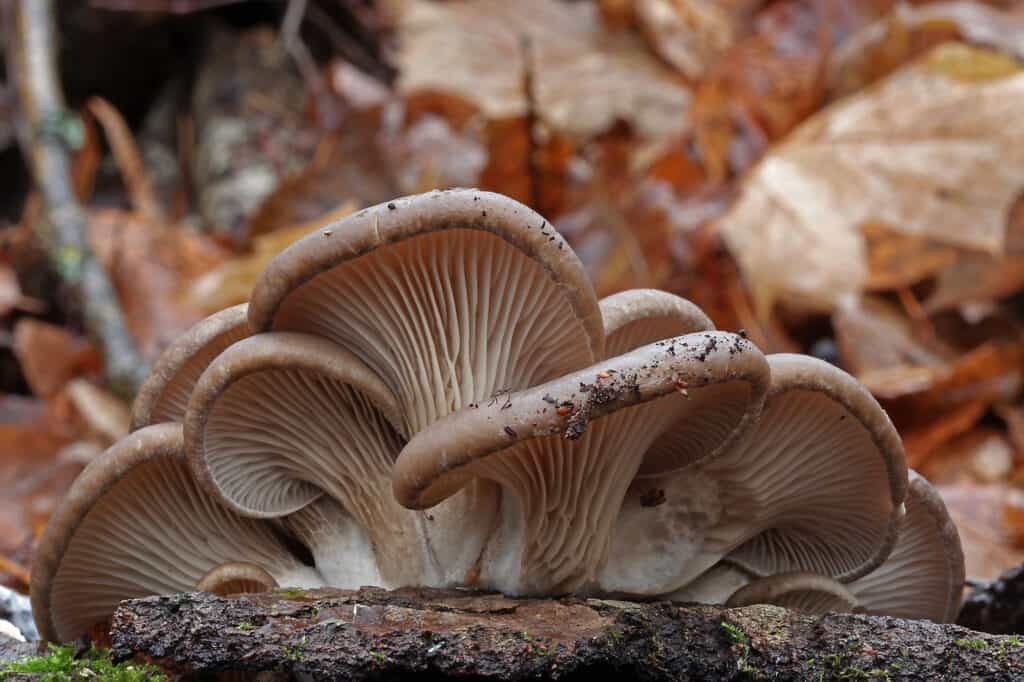
Oyster mushrooms (pictured) can fruit and be foraged year-round but are usually easy to find around fall or late summer.
©NK-55/Shutterstock.com
7. Frost’s Bolete Mushrooms
The frost’s bolete mushroom is classified as exsudoporus frostii and is formerly known as boletus frostii. It’s not too difficult to recognize this mushroom if you’re an experienced forager. Simply seek for the stem that is strongly reticulated in crimson and has a dark red crown. When young, the pore surface appears red, but it has no gills and contains small yellow liquid droplets. They can be seen thriving beneath oak and other hardwood trees. In the United States, they are most prevalent on the east coast from late summer to early fall.
Some compare the flavor of the frost’s bolete mushroom to citrus because of how strongly it tastes like mushrooms with acidic overtones. As there are many dangerous mushrooms that resemble the frost’s bolete, we do not advise foraging for this fungus unless you are skilled and experienced or are accompanied by someone who is an experienced mushroom forager.
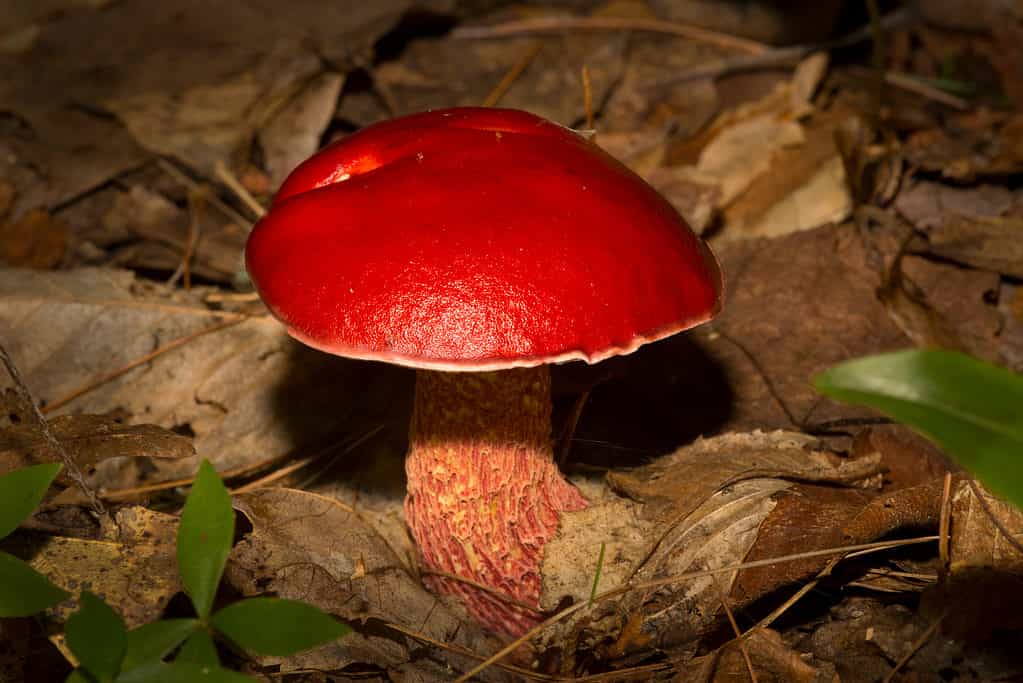
The frost’s bolete mushroom (pictured) is edible, but foraging for this plant is not recommended due to the fact that it looks very similar to toxic red-pored boletes.
©Jeff Holcombe/Shutterstock.com
8. Beefsteak Polypores
The beefsteak polypore is classified as fistulina hepatica. The uncommon beefsteak mushroom is found all across the world, although it is most prevalent in Britain. Additionally, it may be found in North America, Australia, Africa, and Europe. They are somewhat rare in North America. East of the Rocky Mountains is where you’ll see them more frequently. Beefsteak mushrooms are a late-summer-to-early-fall mushroom in North America. Their peak season is in the late summer.
On the sides of oak trees, typically towards the tree or stump’s base, beefsteak mushrooms grow. They do not, however, only develop near the tree’s base; they can also be seen further up. Although oak is the most common species, this fungus is also known to grow on sweet chestnut trees. They frequently develop from the shattered stumps or roots of dead trees. The greatest spot to look is at the roots of recently deceased but still standing trees because that is where it is most frequently found.
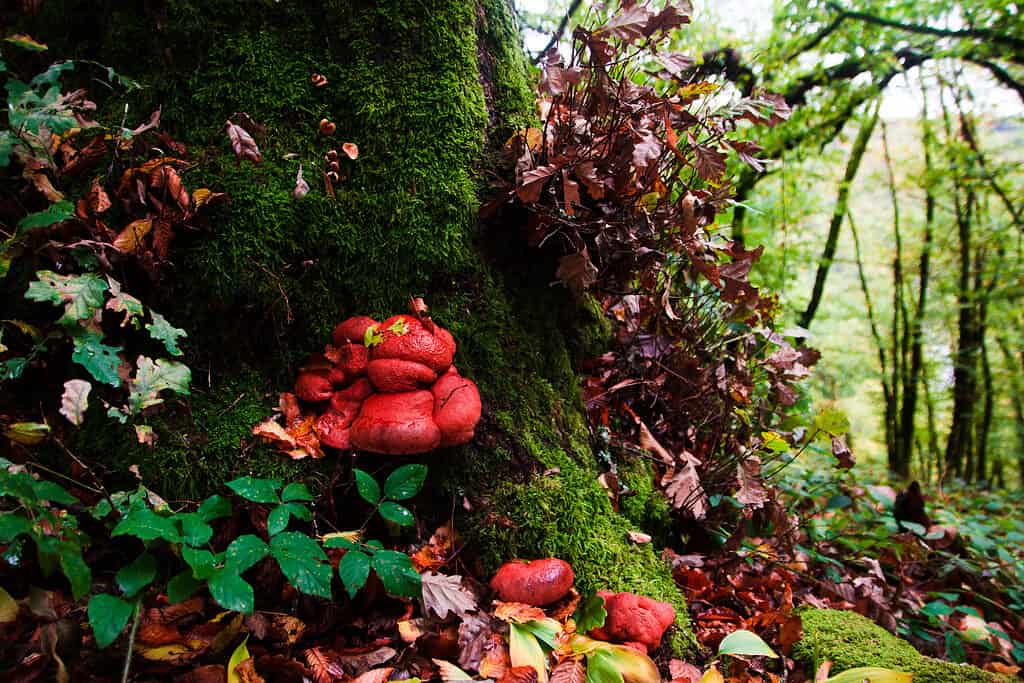
Beefsteak polypores (pictured) can have either a bulbous round appearance or a fan-like appearance.
©malinar/Shutterstock.com
9. Chestnut Bolete Mushrooms
The chestnut bolete mushroom is classified as gyroporus castaneus. These are frequent in the summer, when the boletes are active, in mixed hardwood woods of Eastern North America. They are frequently scattered across forests that contain red and white oak trees. Similar to other boletus mushrooms, this one occasionally grows in small clusters, but more frequently than not, one will find them alone and dispersed across the woods.
The hollow, thin-walled stem of the chestnut bolete may not be truly hollow until it has fully grown. Additionally, while young, it has a rich, chestnut brown crown that progressively becomes tawny or beige.
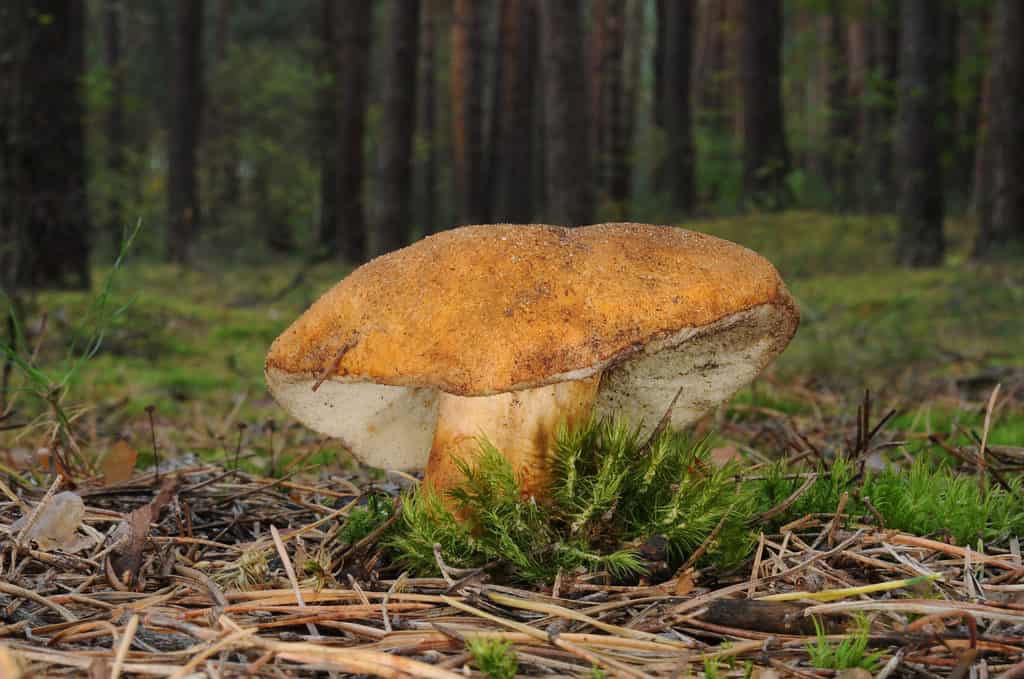
The chestnut bolete mushroom (pictured) can be found growing out of the ground near hardwood trees.
©Tomasz Czadowski/Shutterstock.com
10. Parasol Mushrooms
The parasol mushroom is classified as macrolepiota procera. Excellent mature individuals of this species can be seen from late July into the fall. They can be found in woodlands, untouched grasslands, and meadows.
The parasol mushroom has a cream-white stem that seems to be covered with a snakeskin pattern. It may grow extremely big, up to a height of 10 inches. Additionally, the stem is frequently surrounded by a ring. If handled gently, it can be taken off the stem in one piece.
Parasols taste like your typical cooking mushroom and have a great, dense texture. They do successfully dry pretty well, keeping their aroma and flavor. After foraging, you may enjoy these mushrooms for months by slicing them up and placing them in a dehydrator.

Parasol mushrooms (pictured) have a delightful shape and also happen to be a culinary treat, as they are edible.
©Dar1930/Shutterstock.com
Summary Of 10 Wild Mushrooms Found In Summer
| Rank | Mushroom | Found In: |
|---|---|---|
| 1 | Chicken of the Woods Mushrooms | Dead trees, fallen logs, and stumps |
| 2 | Red Chanterelle Mushrooms | Hardwood forests in Eastern North America |
| 3 | Old Man of the Woods Mushrooms | Native to North America & Europe; most often found in deciduous woods but does sometimes occur under cone-bearing trees |
| 4 | Black Trumpets | Thrive in wet, gloomy places and frequently grow next to streams and washes |
| 5 | Shaggy Mane Mushrooms | Meadows and grasslands throughout North America and Europe |
| 6 | Summer Oyster Mushrooms | Frequently grow on wood, such as decaying logs or tree trunks |
| 7 | Frost’s Bolete Mushrooms | Beneath oak and other hardwood trees |
| 8 | Beefsteak Polypores | Sides of oak trees, typically towards the tree or stump’s base but can also be found further up |
| 9 | Chestnut Bolete Mushrooms | Across forests that contain red and white oak trees |
| 10 | Parasol Mushroom | Woodlands, untouched grasslands, and meadows |
The photo featured at the top of this post is © nomis_h/Shutterstock.com
The information presented on or through the Website is made available solely for general informational purposes. We do not warrant the accuracy, completeness, or usefulness of this information. Any reliance you place on such information is strictly at your own risk. We disclaim all liability and responsibility arising from any reliance placed on such materials by you or any other visitor to the Website, or by anyone who may be informed of any of its contents. None of the statements or claims on the Website should be taken as medical advice, health advice, or as confirmation that a plant, fungus, or other item is safe for consumption or will provide any health benefits. Anyone considering the health benefits of particular plant, fungus, or other item should first consult with a doctor or other medical professional. The statements made within this Website have not been evaluated by the Food and Drug Administration. These statements are not intended to diagnose, treat, cure or prevent any disease.
Sources
- Kyle Pearce, Available here: https://www.inaturalist.org/guides/10718
- Hayden Sammak, Available here: https://www.themeateater.com/wild-and-whole/forage/6-beginner-friendly-mushrooms-you-can-find-in-summer
FAQs (Frequently Asked Questions)
Are summer mushrooms edible?
Most mushrooms that are ideal for foraging and eating can be found during the late summertime in North America.
Are there many mushrooms that are ready for harvest in summer?
Generally, autumn is the best time for foraging mushrooms. However, mushrooms can grow all year round and can be found during summertime as well.
What is the best weather for mushroom foraging?
Summertime, especially very hot and humid summers, is ideal for growing and foraging for wild mushrooms
Thank you for reading! Have some feedback for us? Contact the AZ Animals editorial team.






